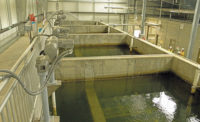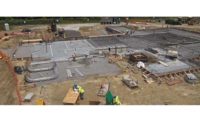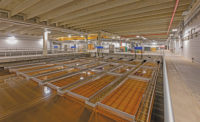Drinking Water
How to Build a Versatile Water Treatment Plant
Three water sources, three treatments challenge construction team at Florida plant

Ion-exchange system’s oversize vessels and tanks, complex network of pipes, valves and vessels, and resin-handling presented the CM-at-risk with unusual logistical challenges.
PHOTO COURTESY GARNEY CONSTRUCTION

Prepared for additional bulk salt storage area for ion-exchange regeneration.
PHOTO COURTESY OF LEE COUNTY, FLORIDA

After degasification, combined waters are disinfected in the clearwell.
PHOTO COURTESY GARNEY CONSTRUCTION



A water treatment plant being built near Fort Myers, Fla., will purify water from three different aquifers with three different treatment systems. The Lee County Utilities’ Green Meadows plant will boost the utility’s treatment capacity to 14 million gallons per day from 9 mgd to address population growth and enhance reliability. The $75.4-million plant will replace a 40-year-old facility and reduce treatment cost per thousand gallons by 60%. After nearly two years of construction, the project is ahead of schedule and under budget.
Two of the new plant’s sources already are serving the utility. “We had an existing allocation in our surficial aquifer and sandstone aquifer,” says Mikes Maillakakis, the utility’s project manager. The regional water authority allowed access to the brackish Floridan aquifer.
The plant’s design concept is somewhat unusual because a water plant typically relies on one source and requires only one treatment system, says Jeffrey Cunningham, associate professor of civil engineering at the University of South Florida Water Institute, in Tampa. “This one is unusual in that they’re drawing from three different depths of ground-water and they’re treating each of the three depths slightly differently,” he notes. Each aquifer’s water has its own chemistry, and every treatment plant matches the treatment with the chemistry of the water, he says.“The surficial water is high in iron and hardness,” Maillakakis says. “To treat the surficial water, we selected the ion-exchange system.” The sandstone water is a very high-quality water, but it contains hydrogen sulfide, which is treated through degasification. For the brackish water from the Floridan aquifer, reverse osmosis is used. After treatment, the waters are combined and disinfected.
First Experience with Large System Ion Exchange
Lee County Utilities selected Garney Construction as its construction manager-at-risk through a request for qualifications. Garney’s construction team has deep experience in water treatment, but “ion exchange, especially a system as large as the one we have, is essentially new to all of us,” says Josh Petro, project manager. The combined challenges include various water flows, requiring a complex network of pipes, valves and vessels; the oversize vessels and tanks sourced from distant points; and the buy out, storage and placement of resin, he says.
Garney holds 13 subcontracts and does not self-perform, Petro says. At peak, the construction workforce numbered over 100. The work is proceeding under three guaranteed-maximum-price contracts.
Construction began in July 2015.
Under the GMP 1 contract, production wells for all three sources and one deep injection well were drilled for the reverse-osmosis concentrate. GMP 2 began in December 2015 for various construction operations. GMP 3 is electrical, instrumentation and controls, and miscellaneous civil work. The project is 61% finished, with completion scheduled for August 2018, he says.
While responsible for engineering the entire project with a fee-only contract, CH2M has teamed with local consultants for some portions, says William Beddow, vice president. Johnson Engineering Inc. is responsible for the water resources, and Fort Myers-based RKS Consulting Engineers is in charge of electrical engineering.
When the new plant is completed, the old one will be closed, but plans for demolition have not yet been announced.






